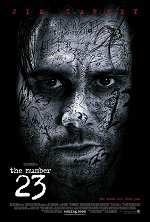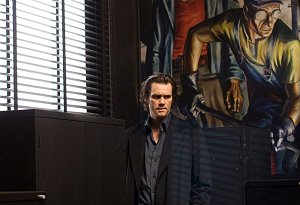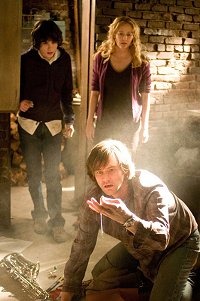 |
|
At The Picture Show
|
March 2007

Fuzzy math
All the silly explanations in the world don't add up in 'The Number 23'
The Number 23
New Line Cinema
Director: Joel Schumacher
Screenplay: Fernley Phillips
Starring: Jim Carrey, Virginia Madsen, Danny Huston, Logan Lerman, Lynn
Collins and Mark Pellegrino
Rated R / 1 hour, 35 minutes
Opened February 23, 2007
 (out of four)
(out of four)
There are two movies being released, one on top of the other, that deal with the
same thing: Obsession. It's always been a recurring topic in the movies - as basic
an emotion as love, anger or fear; as popular a subject matter as revenge.
The first film, Joel Schumacher's The Number 23, is one of those popcorn
psychological thrillers that have been especially popular since M. Night
Shyamalan's great The Sixth Sense was the surprise hit of 1999.
The other, David Fincher's Zodiac, has been lumped into the serial-killer subgenre
but fits better as a police/journalistic procedural.

The Number 23

Zodiac |
Both movies deal with
compulsions of men to understand or deal with something that has, for one reason
or another, gripped ahold of their intellect. Now, naturally, the two have
completely different aims and intentions, so it's not all that fair to compare the
two. But in this case, one of these movies happens to deal with these issues with
exhaustive stupidity, while the other is calm, tactful and intelligent. I'll let you
figure out which is which.
Zodiac is something of a stylistic departure for Fincher, who is known for his
gritty hyperkinetic style in films like SE7EN and Fight Club. In taking on the
infamous Zodiac killer, he doesn't relish in the gory details and macabre
atmosphere he did when he brought us John Doe. Instead, he offers restraint - a
methodical, episodic recreation of an investigation that went through many hands
and took hold in many minds. The obsession that drives the film is that of Robert
Graysmith (whose book is the basis for the film), a cartoonist for The San
Francisco Chronicle who is little more than a voyeur during the original
investigation but who becomes consumed by the case in later years as it becomes
stale old news.
The almost-inexplicable way the Zodiac case becomes his lifeblood is a perfect
example of how to manufacture internal tension. We actually see his family get
pushed to the side, his priorities get thrown out of whack, and as Graysmith, Jake
Gyllenhaal becomes a thoroughly combustible character threatened merely by the
possibility that he will never be able to figure the case out.
Now let's segue back to our main topic, The Number 23. The main character here,
Walter Sparrow (Jim Carrey), also has an obsession. And it, too, begins to tear his
life and family apart. Or so the movie tells us. It never, however, shows us. The
screenplay jumps ahead of itself and never catches up. The plot has hardly gotten
off the ground, and already Walter is pleading with his wife to give him another
chance to save a marriage that we never knew was in jeopardy in the first place.
The film knows where it's going, but has no idea how to get there - only that it
should . . . somehow.
The title refers to a book that Walter happens upon in a bookstore one night. It's
billed as "a novel about obsession," and concerns the titular number and all the
bizarre (possibly Satanic, though the film doesn't seem to know for sure)
connotations that it brings with it. Walter not only buys into the obsession of the
book he's reading - ignoring the common sense that should tell him, and everyone
around him, that one could pull off the same tricks with any other number - but is
disturbed by how closely the novel parallels his own life.
 The film has two narratives going on - both
shoddily constructed. There is the main arc, which is of Walter, his wife, Agatha
(Virginia Madsen, poor woman) and his teenage son Robin (Logan Lerman). (And
no, in case you're wondering, the movie never makes a point about how ridiculous
the name Robin Sparrow is.)
The film has two narratives going on - both
shoddily constructed. There is the main arc, which is of Walter, his wife, Agatha
(Virginia Madsen, poor woman) and his teenage son Robin (Logan Lerman). (And
no, in case you're wondering, the movie never makes a point about how ridiculous
the name Robin Sparrow is.)
He's an animal-control officer, but since his disturbed childhood, he's always
dreamed of being a private detective. That's where the second narrative comes in -
the narrative of the book. It so parallels his own life that he imagines himself in
the title role of a P.I., his wife as the sexy femme fatale and his best friend (Danny
Huston) as . . . well, some sort of bad guy. In both narratives, the protagonist is
obsessed with the number, which he feels holds some kind of unexplained power
and significance. All it takes is some creative mathematics and a big stretch of the
imagination, and he can find the number anywhere.
But "unexplained" is the key word there. I know you're supposed to leave logic at
the door for a movie like this, but when it can't even follow its own twisted logic?
It's practically our duty as moviegoers to tune out at that point.
I have to tread gently around the problems so that I don't ruin it for those poor
souls unfortunate enough to be seeing this movie in the near future. But let's go to
the end. Once 90 minutes have passed and all the film's secrets have been
revealed, there is a very clear series of events that should explain everything.
Once you've seen the movie, think about that series of events. Consider the
timeline. Consider how long each of the events in question would have taken. A
year or two here, nine months there . . .
 If you haven't already, you'll soon realize that
nothing fits. Nothing makes sense. If it were just a slight plot hole, we could
forgive it. But the entire movie rests on the explanation of the film's mysteries.
Which is to say it rests on the absence of any intelligence or even basic common
sense. Didn't the filmmakers ever go back through their own movie to make sure
things worked? Didn't screenwriter Fernley Phillips ever learn how to connect the
dots? Wasn't that, like, first grade? Does he know his colors and his times-tables?
Or did he miss that day as well?
If you haven't already, you'll soon realize that
nothing fits. Nothing makes sense. If it were just a slight plot hole, we could
forgive it. But the entire movie rests on the explanation of the film's mysteries.
Which is to say it rests on the absence of any intelligence or even basic common
sense. Didn't the filmmakers ever go back through their own movie to make sure
things worked? Didn't screenwriter Fernley Phillips ever learn how to connect the
dots? Wasn't that, like, first grade? Does he know his colors and his times-tables?
Or did he miss that day as well?
Consider his logic: A character dubbed the "Suicide Blonde" explains her own
obsession with the number 23, telling us (using numbered values for letters), "My
favorite color is pink! Red is 27, white is 65; 27 plus 65 is 92! Pink has four
letters; 92 divided by four is 23! AAAAAAAHHHH!"
What does her favorite color have to do with it? What does the number of letters in
the word have to do with it? I haven't a clue. Neither does Fernley Phillips.
The Number 23 is further proof that all you really need is a gimmick - not a story
or any characters. But there's so little beneath the surface gimmick that it seems
the actors are just making up the dialogue - and the story - as they go along.
Everything in this movie is either laughably obvious or laughably illogical. Or just
plain laughable.
Welcome to the cinema of Joel Schumacher. This guy's been making crappy
studio pictures for two decades, but this may be his absolute worst. This is the one
that solidifies his spot in the Hollywood Hack Hall of Fame, joining such
esteemed hacks as Chris Columbus, McG, Tony Scott and Renny Harlin. It's easy
to compare his work on The Number 23 to Fincher's work with Zodiac. The latter
provides an extraordinary amount of information in careful detail without ever
becoming the least bit confusing. The former provides little-to-no information, and
yet is impossible to logically understand. Go figure.
Read more by Chris Bellamy